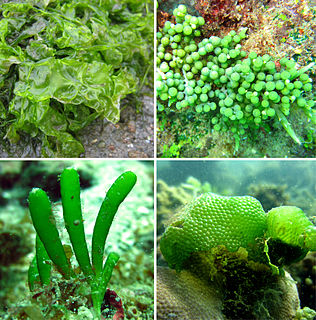
The Ulvophyceae or ulvophytes are a class of green algae, distinguished mainly on the basis of ultrastructural morphology, life cycle and molecular phylogenetic data. The sea lettuce, Ulva, belongs here. Other well-known members include Caulerpa, Codium, Acetabularia, Cladophora, Trentepohlia and Monostroma.

Penicillium is a genus of ascomycetous fungi that is part of the mycobiome of many species and is of major importance in the natural environment, in food spoilage, and in food and drug production.
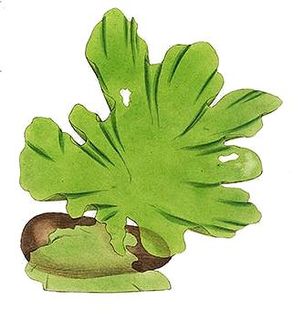
The sea lettuces comprise the genus Ulva, a group of edible green algae that is widely distributed along the coasts of the world's oceans. The type species within the genus Ulva is Ulva lactuca, lactuca being Latin for "lettuce". The genus also includes the species previously classified under the genus Enteromorpha, the former members of which are known under the common name green nori.

Penicillium expansum is a psychrophilic blue mold that is common throughout the world in soil. It causes Blue Mold of apples, one of the most prevalent and economically damaging post-harvest diseases of apples.

Mesophyllum is a genus of red alga belonging to the family Hapalidiaceae.

Oxyrrhis is a genus of dinoflagellates. It includes the species Oxyrrhis marina.

Halimeda tuna is a species of calcareous green seaweed in the order Bryopsidales. It is found on reefs in the Atlantic Ocean, the Indo-Pacific region and the Mediterranean Sea. Halimeda tuna is the type species of the genus Halimeda and the type locality is the Mediterranean Sea. The specific name "tuna" comes from the Taíno language, meaning "cactus" and referring to the resemblance of the thallus to the growth form of an Opuntia cactus.
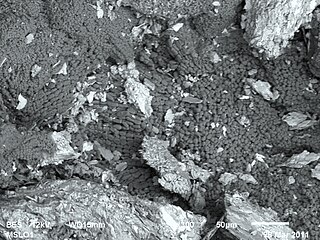
Lithophyllum is a genus of thalloid red algae belonging to the family Corallinaceae.
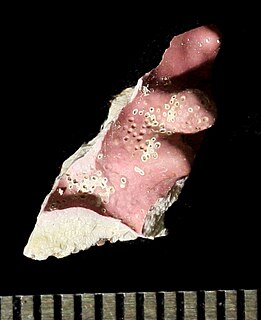
Lithothamnion is a genus of thalloid red alga comprising 103 species. Its members are known by a number of common names. The monomerous, crustose thalli are composed of a single system of filaments which grow close to the underlying surface. Lithothamnion reproduces by means of multiporate conceptacles.
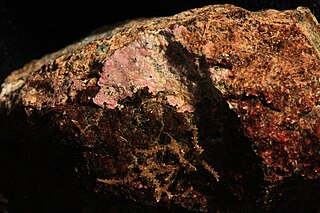
Hildenbrandia is a genus of thalloid red alga comprising 26 species. The slow-growing, non-mineralized thalli take a crustose form. Hildenbrandia reproduces by means of conceptacles and produces tetraspores.
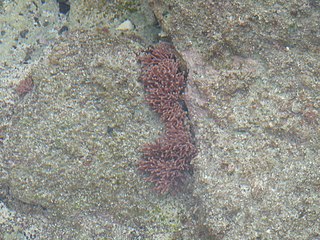
Amphiroa is a genus of thalloid red algae comprising 55 species. Specimens can reach around 30 cm in size. The thalli take a crustose form; dichotomous branches are formed. The organisms possess secondary pit connections. Amphiroa reproduces by means of conceptacles; it produces tetraspores. Its pore canals are lined with parallel filaments; the morphology of the pore canal is a key trait used to delineate species within the genus.

Chorda filum, commonly known as dead man's rope or sea lace among other names, is a species of brown algae in the genus Chorda. It is widespread in the temperate waters of the northern hemisphere. The species also has numerous other common names related to its physical appearance. Names include mermaid's tresses, cat's gut or sea-catgut, bootlace weed, sea-twine, and mermaid's fishing line.
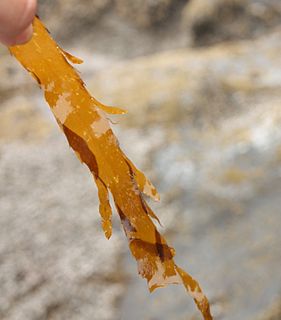
Desmarestiaceae is a family of brown algae, one of two families in the order Desmarestiales. The family gets its name from the genus Desmarestia, which is named after the French zoologist Anselme Gaëtan Desmarest (1784-1838).
Phyllariopsis brevipes is a species of large brown algae, found in the subtidal zone in the Mediterranean Sea. It is the type species of the genus. Unlike other large brown macroalgae, it has a habitat requirement to grow on the living thalli of the crustose red alga Mesophyllum alternans.
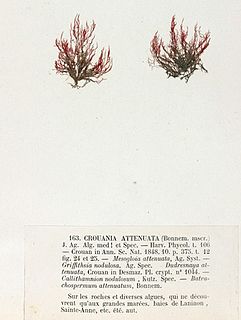
Crouania is a genus of red algae (Rhodophyta) in the Callithamniaceae family. The name of the genus honours the Crouan brothers, Pierre-Louis Crouan and Hippolyte-Marie Crouan. It was first described by Jacob Georg Agardh in 1842, and the type species is Crouania attenuata.
Lithophyllum incrustans is a small pinkish species of seaweed.














